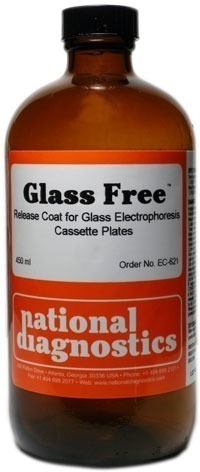Electrophoresis
Glass Free
$147.00
Hazardous Shipping Fees: This product may incur an additional hazardous shipping fee. We will pack the products to minimize all shipping costs, and the final charge will reflect the shipping cost and any applicable hazardous fees charged by FedEx.
Catalog Number: EC-621
Size: 450 ml
- Coats glass casting plates for easy release
- Prevents gel from binding to the upper casting plate
Description
Hazardous Shipping Fees: This product may incur an additional hazardous shipping fee. We will pack the products to minimize all shipping costs, and the final charge will reflect the shipping cost and any applicable hazardous fees charged by FedEx.
Catalog Number: EC-621
Size: 450 ml
Hazardous Shipping Fee
- Coats glass casting plates for easy release
- Prevents gel from binding to the upper casting plate
Glass Free from National Diagnostics coats glass casting plates for easy release of polyacrylamide gels. Glass Free prevents the cast gel from binding to the removable upper glass casting plate. Glass Free, used in conjunction with Glass Bond, guarantees whole, manageable electrophoretic gels time after time. Glass Free is reusable and has a shelf life of two years.
Storage: Glass Free is best stored tightly capped in a cool dry area.
Glass Free method of use:
- For preparing glass plates for gel casting, Glass Free is to be used only on the removable upper plate. Clean the glass with detergent, water, distilled water, and methanol. If the glass plate has previously been treated with Glass Bond, it is first necessary to soak the glass in 20% sodium hydroxide for 3-16 hours and then wash with water and distilled water.
- After the plate is thoroughly dry, immerse it in a dish of Glass Free for 5 minutes, making sure that all areas of the glass are well covered by the reagent. Remove any trapped air bubbles. Always work with Glass Free in a hood. Use latex, PVC or polyethylene gloves.
- Remove the glass plate from the Glass Free vessel and thoroughly rinse it with an organic solvent such as toluene, xylene, or mineral spirits.
- Rinse the solvent off with methanol. Lightly buff out the methanol with a paper towel. The plates are now ready for use. Store them in a plastic bag interleaved with paper.
- To reuse a plate that has previously been treated with Glass Free, wash the plate with water and distilled water and follow by a final rinse with methanol and buff.
Additional information
| Weight | 2.5 lbs |
|---|---|
| Dimensions | 7 × 7 × 11 in |
Protocol
Glass Free Method of Use
Basic Protocol
WARNING: Always work with Glass Free in a hood
- For preparing glass plates for gel casting, Glass Free is to be used only on the removable upper plate. Clean the glass with detergent, water, distilled water, and methanol.
- After it is thoroughly dry immerse the plate in a dish of Glass Free for 5 minutes, making sure that all areas of the glass are well covered by the reagent. Remove any trapped air bubbles. Use latex, PVC or polyethylene gloves.
- Remove the glass plate from the Glass Free vessel and thoroughly rinse it with an organic solvent such as toluene, xylene or mineral spirits.
- Rinse the solvent off with methanol. Lightly buff out the methanol with a paper towel. The plates are now ready for use. Store them in a plastic bag and interleaved with paper.
Note: To reuse a plate that has previously been treated with Glass Free wash the plate with water and distilled water, and follow by a final rinse with methanol and buff.
Safety Overview
Safety Summary (see SDS for complete information before using product):
|
Appearance and Odor:
Clear colorless liquid, irritating fumes.
Highly flammable. Irritating to eyes, respiratory system and skin.
Do not breathe fumes. If swallowed, do not induce vomiting. Seek medical advice immediately and show this container or label
|
EMERGENCY OVERVIEW – IMMEDIATE HAZARDDANGER! EXTREMELY FLAMMABLE LIQUID AND VAPOR. VAPOR MAY CAUSE FLASH FIRE. WATER REACTIVE. CORROSIVE. MAY BE FATAL IF SWALLOWED. HARMFUL IF INHALED OR ABSORBED THROUGH SKIN. MATERIAL IS EXTREMELY DESTRUCTIVE TO THE UPPER RESPIRATORY TRACT, EYES, AND SKIN. CAUSES SEVERE BURNS TO EVERY AREA OF CONTACT.
|



